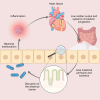Gut microbiota in heart failure and related interventions
- PMID: 38867928
- PMCID: PMC10989798
- DOI: 10.1002/imt2.125
Gut microbiota in heart failure and related interventions
Abstract
Heart failure (HF) is a sophisticated syndrome with structural or functional impairment of ventricular filling or ejection of blood, either causing symptoms and signs or being asymptomatic. HF is a major global health issue affecting about 64.3 million people worldwide. The gut microbiota refers to the complex ecosystem of microorganisms, mainly bacteria, in the gut. Studies have revealed that the gut microbiota is associated with many diseases ranging from neurodegenerative diseases to inflammatory bowel disease and cardiovascular diseases. The gut hypothesis of HF suggests that low cardiac output and systemic circulation congestion would cause insufficient intestinal perfusion, leading to ischemia and intestinal barrier dysfunction. The resulting bacterial translocation would contribute to inflammation. Recent studies have refined the hypothesis that changes of metabolites in the gut microbiota have a close relationship with HF. Thus, the gut microbiota has emerged as a potential therapeutic target for HF due to both its critical role in regulating host physiology and metabolism and its pivotal role in the development of HF. This review article aims to provide an overview of the current understanding of the gut microbiota's involvement in HF, including the introduction of the gut hypothesis of HF, its association with HF progression, the potential mechanisms involved mediated by the gut microbiota metabolites, and the impact of various interventions on the gut microbiota, including dietary interventions, probiotic therapy, fecal microbiota transplantation, antibiotics, and so on. While the gut hypothesis of HF is refined with up-to-date knowledge and the gut microbiota presents a promising target for HF therapy, further research is still needed to further understand the underlying mechanisms between gut microbiota and HF, the efficacy of these interventions, and contribute to the health of HF patients.
Keywords: gut microbiota; heart failure; short‐chain fatty acids; trimethylamine N‐oxide.
© 2023 The Authors. iMeta published by John Wiley & Sons Australia, Ltd on behalf of iMeta Science.
Conflict of interest statement
The authors declare no conflict of interest.
Figures




References
-
- James, Spencer L. , Abate Degu, Abate Kalkidan Hassen, Abay Solomon M., Abbafati Cristiana, Abbasi Nooshin, Abbastabar Hedayat, et al. 2018. “Global, Regional, and National Incidence, Prevalence, and Years Lived With Disability for 354 Diseases and Injuries for 195 Countries and Territories, 1990–2017: A Systematic Analysis for the Global Burden of Disease Study 2017.” The Lancet 392: 1789–858. 10.1016/s0140-6736(18)32279-7 - DOI - PMC - PubMed
-
- Heidenreich, Paul A. , Bozkurt Biykem, Aguilar David, Allen Larry A., Byun Joni J., Colvin Monica M., Deswal Anita, et al. 2022. “2022 AHA/ACC/HFSA Guideline for the Management of Heart Failure: A Report of the American College of Cardiology/American Heart Association Joint Committee on Clinical Practice Guidelines.” Circulation 145: e895–1032. 10.1161/CIR.0000000000001063 - DOI - PubMed
Publication types
LinkOut - more resources
Full Text Sources
Research Materials
Miscellaneous
